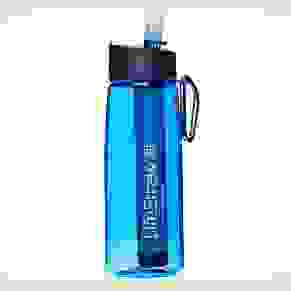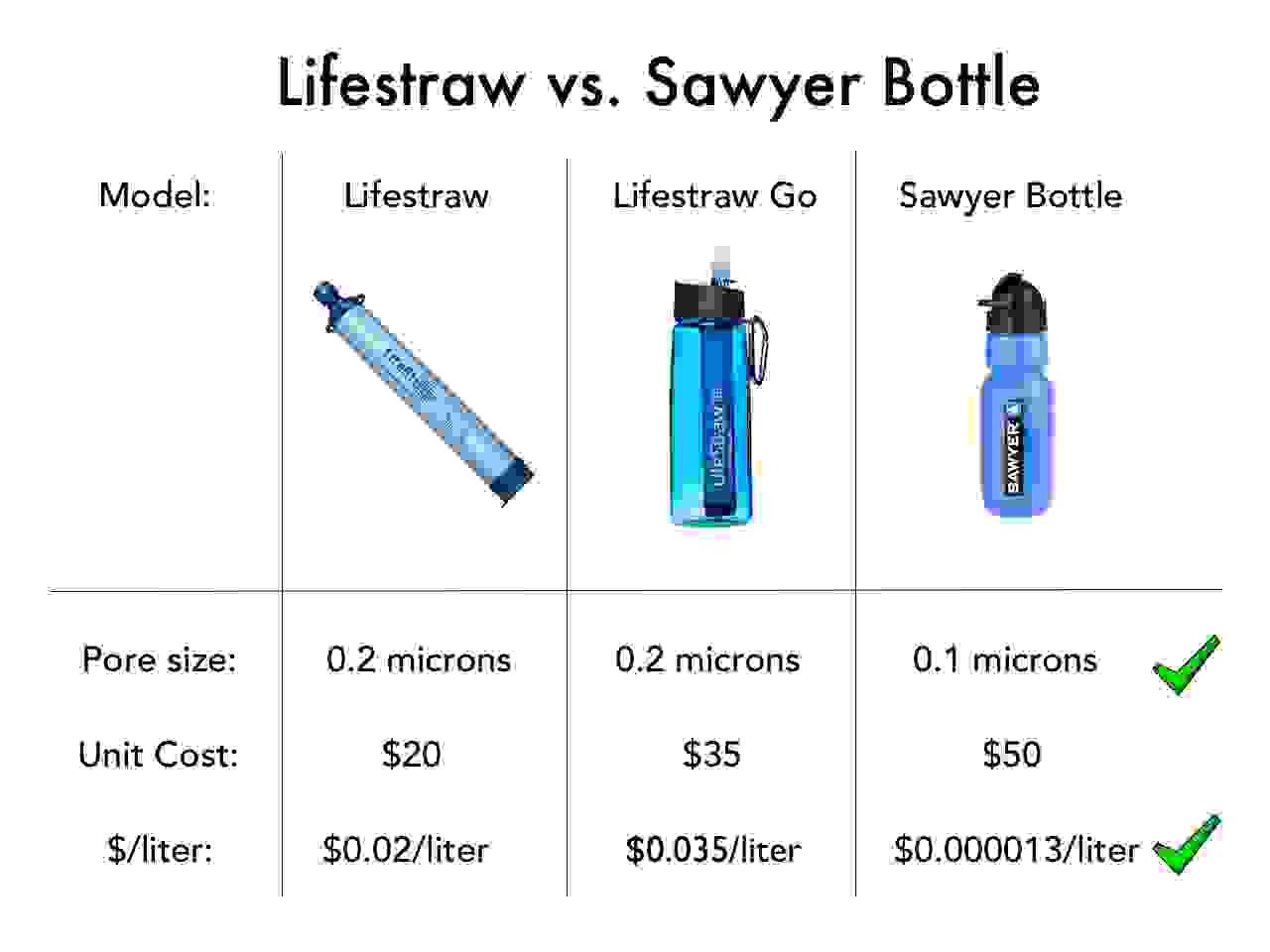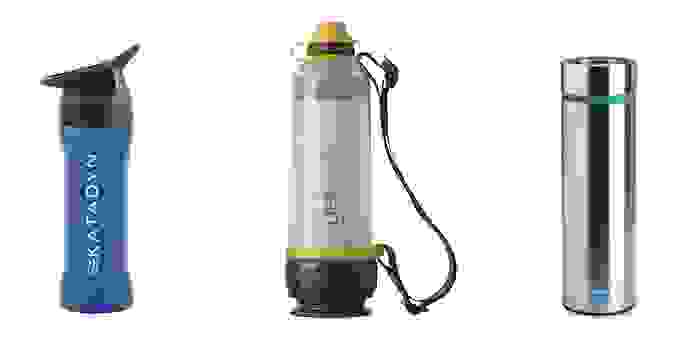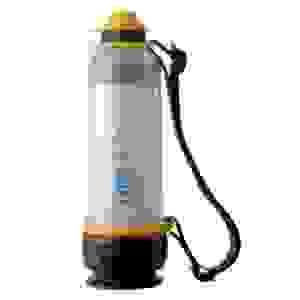Update! As a result of this review, Eartheasy, the North American distributor of the Lifestraw, sent me a few products to try out, and I appreciate when a company is willing to stand behind its products like that. I still feel that the Lifestraw itself is less useful than its fans make it out to be, and that the bottled version is the only version hikers and travelers should consider purchasing. I’ve given specific comments on the bottled version down below, which is worth a look as a portable filter for hiking and other outdoor activities.
As many of you may know, clean drinking water is kind of a big deal. The fact that nowadays we can get drinkable water, right at home, practically for free, is a downright revolutionary (and thoroughly recent) development, and one which remains entirely out of reach for billions throughout the world.
Enter the Lifestraw: A small, lightweight, portable, durable, relatively inexpensive filtration device that can hang around your neck like a necklace, providing you with filtered water wherever you go. It has won an endless string of accolades, and has even been called “one of the ten things that will change the way we live,” with legions of adoring fans singing its praises, swearing by its use in situations of all sorts.
Unfortunately, I think it’s bizarrely overrated.
What’s the Lifestraw?

The Lifestraw is a hollow-membrane filter built into a straw. You place the straw into the water, and drink. Sucking the water up through the straw forces it through the filter, which removes 99.9999% of bacteria, and 99.9% of protozoa, down to 0.2 microns, with a filter that lasts for 1000 liters, for about $20. Not bad, right?
That’s pretty good, but on the downside, it won’t remove microscopic minerals, chemicals, or viruses.
This isn’t necessarily a deal-breaker, since most water will be fine, especially if you’re just filtering river water to avoid getting sick…but this thing was designed for the third world, with viruses all over the place, meaning you’d need iodine or other methods to eliminate the potential threat of viral diseases.
It’s certainly better than nothing, and preventing most water-borne diseases is better than preventing none. The Lifestraw was designed to provide excellent filtration at a reasonable cost, which is probably more effective than providing perfect filtration at a high cost, which could very well be too expensive to accomplish its own goals of third world disease reduction. Again, missing the viruses isn’t a deal-breaker, and it can prevent a huge number of water-borne diseases from infecting at-risk populations, but people talk about this thing like it’s the messiah of water filters.
But that’s not even the most annoying part.
The weird problem no Lifestraw review ever seems to mention
I have gone over this problem again and again in my head, looking at the endless cavalcade of glowing Lifestraw reviews, “Invention of the Century” accolades, and legions of ardent fans, and cannot fathom why no one seems to notice or care.
Take a look at the snazzy in-action shot of a guy using the Lifestraw out in the real world:

What happens when you walk away from the water?
No more water.
So if you’re heading into riverless mountains, or the desert, or a 12 hour bus ride in body-temperature heat, or any other situation in which you won’t have access to water, you’ll have to fill up a water bottle ahead of time, and whenever you want a drink of water, you have to:
- Open the bottle
- Open the Lifestraw’s top cap
- Open the Lifestraw’s bottom cap
- Stick the Lifestraw inside
- Drink
- Take it out
- Expel the remaining water
- Close the top cap
- Close the bottom cap
- Close the bottle.
And then…you’ve got a wet Lifestraw, so you’ll probably end up with wet clothes. Sexy!
People talk about how “simple” this is, as if handling three caps instead of one is somehow…simple?
On a related note, imagine traveling with this thing, and trying to fill up from a sink. You’d have to plug the sink, fill it up, wait for it to get deep enough to drink, then take a few sips, unplug the sink, and walk away. Imagine being incredibly thirsty and trying to do this in a hurry. Now imagine you’re about to get on a 12 hour bus ride through midday temperature highs, and all you had ahead of time was a quick sip from the sink, and that’s all you’ll have until the next time you get to another sink, when you’d begin the sink plug process anew. Just for one sip.
Seriously, has anyone actually used this thing?
What the Lifestraw should have been

So here we finally are, at a product that’s actually recommendable. The Lifestraw Go. They took the Lifestraw and stuck it inside a water bottle, which eliminates the pointless inconvenience of only being able to drink with water nearby, or having to deal with three different caps and two separate objects for every sip.
But damn…the Lifestraw has been around since about 2005, and this bottled version only started shipping around 2013. This means that for 8 long years, nobody ever bothered asking “Dude, what if you walk away from the river but you’re still thirsty?” Sigh.
This bottled version was designed for the consumer market, which makes a lot of sense, and it’s true that shipping a million regular Lifestraws to disaster zones or poverty-stricken rural areas is logistically easier than shipping a million bottled Lifestraws, as they’d need maybe 5 or 6 times as many shipments due to the size, but damn…how does anyone use the regular one more than a few times without going crazy?
While it’s true that the original Lifestraw was designed for simplicity, portability, durability, and ease of use (and somewhat succeeds), I just can’t see many good reasons not to stick it inside a water bottle in the first place. Particularly from a consumer standpoint, the bottled version is clearly the correct answer here.
Update: I can think of ONE situation in which the straw by itself might be more useful than a bottle: Trail running, near a river. You can strap it to your leg, so it doesn’t bounce around, and you’re always near an outdoor water source, which would only need this type of filtration, and wouldn’t need a bottle.
But, ranting aside, is it a good filter? Is it a cost-effective solution to commonplace water purification needs, third world or otherwise? Could this be the one and only water purification method you employ, whether hiking in the mountains, or adventuring throughout the developing world?
Well…maybe.
Remember, it still can’t filter viruses, which is what you’d want in developing countries.
That’s not to say it’s not useful. A $35 water bottle that provides 0.2 micron filtration which lasts for 1000 liters certainly isn’t bad.
But on the other hand, you can just get the Sawyer Water Bottle, which manages 0.1 micron filtration for a guaranteed 3.7 million liters for a one-time cost of $50.
Um…tell me again, why is the Lifestraw so popular?

It has been claimed that the Lifestraw’s lifespan estimates are intended to be a little on the safe side, using low-quality water for all of its tests, which is good (and Sawyer’s lofty claims were put to the test, and were sadly shown to come up short, so the performance difference is likely to be smaller than what is claimed). And again, it’s not that it’s bad, and the filtration quality will probably work just fine if you’re hiking in North America, and you could supplement it with iodine tablets if you ever take it with you to Mexico, or wherever else you might want anti-viral protection. And if you’re drinking a liter of water per day, a $35 Lifestraw Go will last almost 3 years, which isn’t bad at all, and if you’re only using it for camping trips on weekends, it’ll last much longer. I also think it looks nicer than the Sawyer. So it’s definitely good; it’s just not necessarily the best, neither on filtration quality, nor on cost-effectiveness.
Update: After receiving and using the Lifestraw Go, I can say that it’s a pretty good product for hikers who plan on filling up from a river and just want a simple water bottle filter to do the job. Its filtration performance isn’t as strong as the Sawyer, nor is it as cost-effective, but it’s still effective and affordable, for non-viral filtration. Keep in mind it’s supposed to filter biological contaminants rather than chemical, meaning it’s more suited to filtering clear river water than tap water, which is more likely to have chemicals of some sort.
Two issues: Firstly, the Lifestraw Go does not use the regular Lifestraw as a replacement filter, but instead uses a slightly modified version. This means you cannot replace the filter inside the Lifestraw Go with a regular Lifestraw, and, at the moment anyway, you cannot buy just the replacement filter by itself. When your Lifestraw Go reaches the end of its life, you’ll have to buy an entirely new bottle. I expect that if the product is successful that they will offer those replacement filters by themselves, but it’s worth being aware of this issue.
Secondly, when the bottle is shut and the straw is folded down, it protrudes slightly beyond the edge of the lid, and it’s easy to get your grubby hands all over the straw when you pick up the bottle, potentially getting the straw a little dirty and thus defeating the purpose of drinking filtered water. This could be easily fixed, and I hope they do it. Second update: THEY DID!
If you think it’s for you, check it out here.
But again, neither of these devices will provide chemical or viral filtration. If you want to get rid of viruses, then you’ll need iodine tablets, or a UV light, or upgrade to a water bottle that actually gets rid of viruses, too.
What if I need serious purification?
For most people, high-quality filtration works just fine. If you’re hiking in North America or filtering tap water while traveling through modern countries, you probably don’t need virus removal to be safe. But if you’re traveling in developing countries with incredibly questionable tap water, you might want to take some extra precautions.
And yes, you can fit a whole purifier right inside a water bottle, like these do:

Each of these will clean out viruses, along with all the other contaminants, including chemical, that you’d want removed, providing thorough filtration beyond anything the Lifestraw can manage. Check out a thorough review of those three, including short and long term cost estimates, and suggested uses for each. They all work differently, without any objectively “best” option, so you’ll want to find a favorite that works for you. I’m currently using the GRAYL, which manages the nice trick of allowing multiple options for filtration quality as needed, and also looks nice and classy.

But I’d also like to highlight a close competitor to the Lifestraw, one which shares the design goal of providing high-quality, portable, durable water filtration to vulnerable populations in the third world, and which demonstrates what the Lifestraw could have been. It’s the Lifesaver Bottle, and it’s 13 times better.
The pores in the Lifestraw are 0.2 microns, whereas the pores in the Lifesaver are 0.015 microns, making them about 1/13th the size, which is small enough that viruses can’t get in. No more worrying about having to use iodine tablets.
It’s true that the Lifesaver is bigger, heavier, bulkier, and significantly more expensive (though long-term costs are actually quite good), whereas the Lifestraw was supposed to be so tiny and portable that you can take it with you wherever you go, which might actually mean it gets used more frequently by those who don’t want to bring along a bottle all the time. But…if you need a bottle anyway, and you want portable virus filtration, the Lifesaver wins.
Yet nobody seems to know it exists.
So why does everyone love the Lifestraw?!?!
Well, I don’t really know. It was even called the “Invention of the Century,” from a publication I otherwise enjoy, despite lower performance and higher long-term cost than competing options that have been on the market for years.
Again, it’s not bad, and the bottled version solves quite a bit of the silly ridiculousness of the straw-only version, but everyone adores the straw-only version, as a consumer product, which is absolutely inexplicable to me.
But I have a theory:
At $20, it’s cheaper than many other filters, and, admittedly, its filtration capability is pretty good, and a lot better than most of what I’ve seen for the same initial cost. It has a nice impulse-buy price point that gets people interested, and its unique design sets it apart in a world of filtered pitchers, faucet adapters, and so on. And when it arrives in the mail, people give it a try, drinking from a cloudy glass of water, and impressing some friends. Buyers are left happy.
And then they never use it.
Seriously. If you read the Lifestraw reviews on Amazon, you’ll see lots and lots of people talking about how great it is, who stuffed it into an emergency preparedness kit and never bothered with it again. They’re rating the product on how cool they think it is, not how practical it is in real-world use.
People actually love it so much that they videotape themselves drinking from jars of water full of feces…which is explicitly something the Lifestraw cannot handle, because water contaminated this way can easily have viruses inside, which the Lifestraw is incapable of removing. There’s a level of enthusiasm for this product that is literally dangerous.
So is the Lifestraw useful at all?
I would like to clarify that I am examining the Lifestraw from a consumer standpoint, rather than from a disaster-relief or third world disease alleviation product. It offers plenty of functionality in those situations, especially the Lifestraw Family, which is a larger (though still portable) filter intended for home use that does remove viruses. Most of my annoyance should be directed toward the overrating fanboys, who post videos of people drinking toilet water, and then resort to third-grade name-calling if anyone ever criticizes its performance or design.
So it’s certainly not horrible, particularly the bottled version, which is the only one you should bother looking at. Its filtration capability is actually quite good, and it’s pretty convenient. I just think it has been played up way too much in the media, and people salivate over it like it’s this work of art that no disaster-preparedness kit should ever be without.
Just remember that it is incapable of handling chemical and viral contamination, meaning you should only use it within a narrow band of circumstances; outdoor recreation, in North America (and similar settings), where the water you come across has neither chemicals nor viruses.
So it’s certainly worth a look, but I can’t say it’s the best. Competing products provide better filtration at a more cost-effective price, while other devices handle viruses as well, which is what you’d want in developing countries.
Check it out, but remember to…filter some of the adoration.




Wow lots of responses, it’s one persons review….
I’ve used all the products mentioned in this article & they all have there place, & all have their pros & cons just like everything. The Lifestraw is great for what it is. It’s super small, light & great for the US. Not the best for an American to avoid viruses in say Belize. Did a trip down there w/ a dozen of us & we were all given Lifestraws, all of us got sick. Spending 2 weeks w/ one basically glued to your body you learn a few things & yes it leaks all over you every time you’re finished w/ it. I have a few of them for hikes in the states & epoxied on a long flexible tube that I simply drop into the river when I want a drink. Works fantastic, it’s so simple & fast I love it. Plus I don’t need to take my pack off.
If you want a water bottle than yeah the Sawyer pretty much crushes most other companies. Fill it up, & drink out of it, pretty simple. Plus I really like how it cleans, but I’ve broken the top of the bottle on 2 of them.
When I trail run or do short 1-2 day hikes & use my camelback. I cut my hose & put in Sawyer’s inline filter. Works great but I’ve found that over time I’ve already had to replace the hose on my camelback twice, it keeps splitting as I like to dry mine out for cleaning.
All those fancy new bottles I’ve tried but they are significantly heavier & bulky compared to the Lifestraw & Sawyer products. My wife has the LifeSaver Bottle & thinks it’s the greatest product she’s ever used in her outdoor life. I prefer the Lifestraw I modified. Is she right? Am I? I think we’re both happy with the products but for different reasons. I’ll be buying more of all of them, I’m just hoping that the Lifestraw can increase its lifespan, I go through 1 a year.
Hope to see you all out on the trails, tread lightly & stay hydrated.
Wow, reasonable commentary! I was definitely not expecting this level of sensible communication from a discussion concerning the Lifestraw, given the conversation thus far. What you say makes a lot of sense, and that’s quite a refreshing change.
It’s the best thing since sliced bread because of the big thing called advertising, and on top of that, the relief effort and charity intentions that they so prominently like to put out for their clientele of people with good intentions. This gives them more credibility for when they reach out to the other groups.
Look at their amazon page again and you’ll see the picture of the fly fisherman with the Lifestraw hanging from his vest like an infrared beacon. The outdoorsman, the gung-ho boot Marine, and, I almost wish to digress, the prepper. We’re so hell bent on the idea of our own self destruction or a disaster scenario that they don’t know of what else to do with themselves but buy and buy and buy hundreds of dollars of equipment that they’ll likely use to humor themselves now and then.
Not to say the Lifestraw is one of the unnecessary products. If it works, it works, and the cheapest price I’ve seen on amazon is somewhere under 20 USD. For a personal filtration device that last 1000 Liters of contaminated fluid, that’s not bad. Granted, as an outdoorsman, I personally wouldn’t use this in my day to day as I make sure to bring enough water to last me the day. When your water starts to run out, it’s time to turn in. But in a situation where this is needed, and if it’s all I’ve got, I’m going to use it.
I’m not going to be as pissed about not being able to carry water when I have something that can filter it there on the spot and quench my immediate thirst. A waterbottle with a lifestraw installed? Sure. Why not. If the stats are better on another product, why not. I always believe you get what you pay for. But if I needed supplies and a stranger in passing handed me a sealed life-straw package, I wouldn’t look a gift horse in the mouth.
Some people will sit down in front of two puzzles and open both of them.
Then they will pull a piece out of one box and try to intelligently tell you what is wrong with the puzzle or the puzzle piece by comparing it to the other puzzle.
I before I finished reading the third paragraph of your review, I had a point of view that you are a just such a person.
I finished reading at the point where you use strong ignorance as a logic weapon to discount the value of this product. Saying that this product is not wonderful just because it doesn’t work in the desert or on a dry mountain side is ignorant. If I may make another analogy, it would be like writing a review on what a bad invention the screw driver is since it can not drive a nail into a board.
If there is anything of value in your blog, I won’t find it because I’m already convinced of your abundant ignorance and I am leaving your page.
I’ll stick with the objectively better options that can handle whatever comes along, thank you very much. But to each his own.
I think you should read
http://www.cdc.gov/healthywater/drinking/travel/backcountry_water_treatment.html
And pay attention to what iodine can’t do, what filtering can’t do, and who should not use iodine.
Here’s something else all Lifestraw reviews fail to mention. Millions of Lifestraws have been given away free of charge to residents of many third world nations by the manufacturer. Has any other product that you like better been given away in such large quantities for free by the manufacturer? Surely this must be an amazing act of charity and humanity at it’s best, right? Of course it’s not. Vestergaard Frandsen, the company behind the Lifestraw, gives the straws away to poor nations in return for that nations carbon credits. The story goes that if said country uses life straws to filter water they wont need to use fire to boil it. Thus, no release of harmful carbon gasses into the atmosphere. Vestergaard Frandsen then sells those credits to the likes of China and other burgeoning countries that release too many carbon emissions. The carbon credits allow the countries to avoid the carbon taxes imposed for overproduction. This is how Vestergaard Frandsen makes most of it’s money. Not in retail sales of it’s products. I still own one however. It’s all I ever use. It works perfectly for me. I live in an area of Florida surrounded by rivers, creeks, ponds and springs so anything else would be overkill. I have also never laid on the ground to drink through my straw. I’m either in the water swimming or I submerge a gatorade bottle into the water and drink from that through the straw. The main reasons I use a gatorade bottle is that it can be cheaply replaced eliminating storage issues when packed away at home. It never needs to be washed only thrown away or preferably recycled or upcycled. Bottom line for me is that It’s Light and Small, It’s Cheap, It Works, It’s Easily replaced If lost or damaged. But to each their own.
See, this is the kind of respectful commentary that’s actually useful. I can imagine certain situations where people might prefer this method, but it’s so rare to hear them say so. And I had read about the carbon credit criticism, but I didn’t know enough about it to offer insight, so I wanted to focus on the performance here.
You think companies don’t need to make money to support themselves and that producing the item has no cost?
This seems like it was written by someone who was simply determined to dislike something in order to fulfill their need to be snarky and narcissistic and any other adjectives that makes him feel different and for whatever reason, that he is interesting. I’d be more worried about where that mentality is coming from than the authors inability to manage three different caps… although that could be a cause for concern as well.
Oh my gosh! Something a lot of people like isn’t exactly perfect! This has never happened before, because every single consumer product is absolutely perfect. You should definitely complain on the internet about it.
Quite agree with your comments. One thing I might add is the cleaning process. I have a self inflating air mattress from a well known company. After a few years of owning it it would not self inflate. I began blowing into it on a regular basis to raise it to my liking. One day I was warned by a fiend that this would cause the mattress to get mouldy inside. I didn’t realize it before this and immediately clued in to why I smelt an odour when deflating the mattress. Back blowing into the straw for cleaning, would this not create the same issue eventually? This mould would not be getting filtered as it would be at the top of the filter. The human end …
Yeah…all the bacteria in your mouth would go into the “clean” end of the straw. It’s probably safe bacteria, because it was inside of you anyway, but it could potentially build up. I haven’t heard of people running into this problem, but that’s why easily cleaned products are always helpful.
Puresip is $19.99 made in USA and not just traps, kills viruses, kills bacteria, and clogs when no longer useful.
Simple and effective in most application.
What are your thoughts?
That definitely looks like a better option than the Lifestraw, as it kills viruses too; I do sort of wonder what sort of material it uses to do that, as it’s usually some sort of chemical, and I don’t see those details on their site. But it’s also still just a straw…if you like the straw, then yes, it’ll work, but I’d prefer to see it in a bottle instead.
Is the Life Straw going to remove the geordia or cocccidia found in Zion? Or, do you have to use iodine?
I think it removes everything other than viruses. It’s just a size issue, and viruses are smaller. The ones you mentioned are protozoa, and it claims to remove 99.9% of protozoa.
I would recommend buying a Lifestraw (good on it’s own, better when paired), in addition to a Klean Kanteen (or my personal favourite) the Nalgene Stainless 1L Water Bottle. Not only can you scoop-up a bottle of “contaminated” water, then take it with you in a hurry and filter on the go, but you can also boil water in the Nalgene… something that’s widely overlooked in projected survival scenarios.
Just my .02